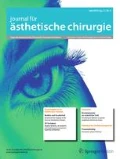Zusammenfassung
Narben können funktionell und ästhetisch problematisch sein. In der Narbentherapie haben topische, chirurgische und Laserverfahren ihren Platz. Wir stellen die Korrektur von Narben mittels Hyaluronidase-Injektionen als weitere Alternative vor. Hierbei kommt es im Verlauf mehrerer Sitzungen zur schrittweisen Verbesserung der Texturveränderungen, Minderung der Straffheit und Unterstützung sekundärer Wundheilungsvorgänge. Dies zeigt sich in der Verbesserung der Vancouver Scar Scale von 6,3 ± 1,9 vor der Therapie auf 2,1 ± 1,6 nach Abschluss. Zusammenfassend kann die Hyaluronidase-Injektion als sichere und wirksame Alternative zu operativen und laserbasierten Narbenkorrekturen angesehen werden.
Abstract
Scar tissue can cause both functional and aesthetic problems. Scar treatment includes topical, surgical and laser-based procedures. We report on scar correction by the use of hyaluronidase injections. During the course of several treatment sessions there is a step by step improvement of scar tissue with respect to texture, tautness and secondary wound healing. This is also demonstrated by improvement in the Vancouver scar scale from 6.3 ± 1.9 before treatment to 2.1 ± 1.6 after treatment. In conclusion, hyaluronidase injections are a safe and effective alternative to surgical and laser procedures to correct scars.


Literatur
Zhu Z, Ding J, Tredget EE (2016) The molecular basis of hypertrophic scars. Burns Trauma 4:25
Shroff A, Mamalis A, Jagdeo J (2014) Oxidative stress and skin fibrosis. Curr Pathobiol Rep 2:257–267
Buhren BA, Schrumpf H, Hoff NP et al (2016) Hyaluronidase: from clinical applications to molecular and cellular mechanisms. Eur J Med Res 21:5
Sullivan T, Smith J, Kermode J, McIver E, Courtemanche DJ (1990) Rating the burn scar. J Burn Care Rehabil 11:256–260
Prockop DJ (2016) Inflammation, fibrosis, and modulation of the process by mesenchymal stem/stromal cells. Matrix Biol 51:7–13
Vigetti D, Karousou E, Viola M, Deleonibus S, De Luca G, Passi A (2014) Hyaluronan: biosynthesis and signaling. Biochim Biophys Acta 1840:2452–2459
Wang Y, Han G, Guo B, Huang J (2016) Hyaluronan oligosaccharides promote diabetic wound healing by increasing angiogenesis. Pharmacol Rep 68:1126–1132
Moreno A, Martínez A, Olmedillas S, Bello S, de Miguel F (2015) Hyaluronic acid effect on adipose-derived stem cells. Biological in vitro evaluation. Rev Esp Cir Ortop Traumatol 59:215–221
Jackson WM, Nesti LJ, Tuan RS (2012) Mesenchymal stem cell therapy for attenuation of scar formation during wound healing. Stem Cell Res Ther 3:20
Martín-Cartes J, Morales-Conde S, Súarez-Grau J et al (2008) Use of hyaluronidase to prevent peritoneal adhesions in laparoscopic ventral hernia repair by means of intraperitoneal mesh fixation using spiral tacks. Surg Endosc 22:631–634
Tateya I, Tateya T, Watanuki M, Bless DM (2015) Homeostasis of hyaluronic acid in normal and scarred vocal folds. J Voice 29:133–139
Favorito LA, Gallo CB, Costa WS, Sampaio FJ (2016) Ultrastructural analysis of the foreskin in patients with true phimosis treated or not treated with topical betamethasone and hyaluronidase ointment. Urology:. doi:10.1016/j.urology.2016.07.007
Wollina U (2015) Nonsurgical scar revision by hyaluronidase – a case series. Kosmet Med 36:164–166
Goyal NN, Gold MH (2014) A novel triple medicine combination injection for the resolution of keloids and hypertrophic scars. J Clin Aesth Dermatol 7:31–34
Rajalakshmi AR, Kumar MA (2016) Hyaluronidase hypersensitivity: A rare complication of peribulbar block. Indian J Ophthalmol 64:160–162
Author information
Authors and Affiliations
Corresponding author
Ethics declarations
Interessenkonflikt
U. Wollina hat Vortragshonorare von Riemser erhalten.
Dieser Beitrag beinhaltet keine vom Autor durchgeführten Studien an Menschen oder Tieren.
Additional information
Dieser Beitrag basiert auf einem Vortrag bei der Jahrestagung 2016 der Gesellschaft für Ästhetische Chirurgie (GÄCD) in Köln.
Rights and permissions
About this article
Cite this article
Wollina, U. Narbenkorrektur mit Hyaluronidase-Injektionen. J Ästhet Chir 10, 111–113 (2017). https://doi.org/10.1007/s12631-016-0068-x
Published:
Issue Date:
DOI: https://doi.org/10.1007/s12631-016-0068-x

